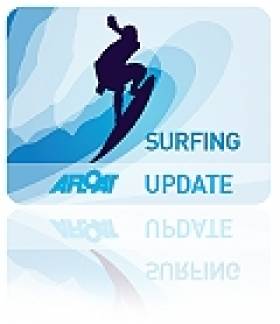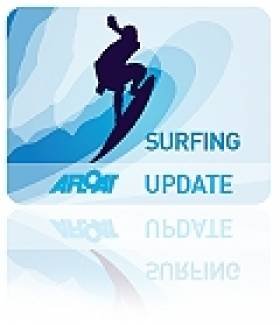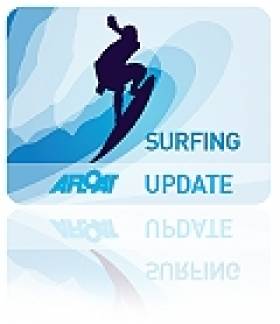Displaying items by tag: Surfing
Surfing Film Unites Descendants of Blaskets King
#Surfing - The Blasket Islands are the setting for a new documentary following the exploits of two surfers descended from the ancestral 'king' of the island chain.
IrishCentral reports on The Crest, the story of two distant cousins from opposite sides of the United States - Andrew Jacob from Massachusetts and Dennis Kane from California. Though previously unknown to each other, the two nevertheless share a deep passion for surfing.
And it's the waves that bring them together as they unite in the land of their great-great-grandfather to indulge their obsession and ride the giant swells for which the west of Ireland is becoming so renowned.
Indeed, Canada's National Post is just the latest to discover the attractions of surfing at Lahinch and the Cliffs of Moher
Crowdfunded via a Kickstarter campaign, the documentary crew already shot footage in Cape Cod and San Diego before decamping to the Blaskets off Kerry last month to shadow the cousins as they connect to their roots.
The film is directed by Mark Corvino, who co-directed the current film festival favourite music documentary A Band Called Death.
Cillian Murphy Lands Plum Role In Maritime Movie
#AtTheMovies - The Irish Independent reports that Irish actor Cillian Murphy has signed on to appear in new maritime adventure film The Heart Of The Sea.
Ron Howard is directing the adaption of the Nathaniel Philbrick book, which follows the fortunes of the whale ship Essex and its encounter with an angry sperm whale in the South Atlantic.
Murphy - who previously narrated the award-winning surfing documentary Waveriders among his prestigious blockbuster credits - will play the ship's second mate.
The film also features Thor star Chris Hemsworth, and is set to begin shooting in the UK this September.
#Tourism - The world-class surfing hotspot of Sligo has failed to make the grade in Fáilte Ireland's long list of leading tourism towns for 2013, according to the Irish Independent.
The north-east county was among a surprise selection of areas known for their maritime and waterways attractions - such as Westmeath on the Shannon and Galway, host of last year's Volvo Ocean Race finale - that were not featured in the Irish tourism board's list of 45 towns and villages put forward for the Highly Commended Tourism Towns award, part of the National Tidy Towns Awards to be announced later in the year.
Counties on the water that did make the cut include Clare and Mayo, with five towns each on the list, Kerry with four - including last year's winner Portmagee - and Donegal and Waterford, represented three times each.
The top prize winner, to be announced by Fáilte Ireland in November, will receive €10,000 in supports for tourism marketing and development.
Though Sligo is conspicuous by its absence, Donegal's triple placing shows the north-east region is a big tourism attraction - and the Tripclocker blog says surfing is at the forefront of that.
With Ireland's exposure to the open Atlantic giving is "better waves more often", according to Killian O'Kelly of Bundoran's Turn n' Surf, there is a wide variety of surf beaches stretching from Donegal to Clare in particular with swells for all levels of experience.
#News - IrishCentral reports that a surfing instructor has been cleared over the death of an American tourist on a beach in Co Kerry two years ago.
Rowan Minjon of Castlegregory had pleaded not guilty to the charge of dangerous driving over the death of Kentucky woman Jenna Hill, who was struck by a reversing truck on Inch Beach in Ardroe on the morning of 2 July 2011 and suffered severe head injuries.
The trial at Tralee Circuit Court heard that the truck driven by Minjon - employed by the Offshore Surf School at the time - had no working horn nor reverse lights.
But Garda vehicle inspector Jim O'Brien said Minjon had not been aware of Hill's presence on the beach, and claimed that she should have noticed the "big bright noisy and near" truck as it approached.
IrishCentral has more on the story HERE.
#Surfing - Two national broadcasters will base themselves in Bundoran this week ahead of the Sea Sessions Surf Music Festival at the weekend.
Today FM’s KC Show will broadcast live from the Bundoran RNLI Lifeboat Station tomorrow 19 June and Thursday 20 June, while 2FM will broadcast from the Sea Sessions from Friday 21 to Sunday 23 June, giving the seaside town unprecedented national media coverage for five days.
As part of a recent Discover Ireland promotion on Today FM, listeners were asked where to send the various shows to on their holidays. Listeners to the KC Show had a choice of sending him to Dingle or Donegal and following thousands of votes, Donegal came out on top.
One of the locations suggested was Bundoran, and the RNLI Lifeboat station at the pier was chosen as the home for the KC Show for two daily broadcasts this week complete with live musical guests Walking With Cars and new Irish act Daithi.
No sooner will Today FM have packed up than the 2FM Roadcaster will be rolling into the Main Beach car park and preparing to broadcast from the Sea Sessions on Friday, Saturday and Sunday.
The national state broadcaster will give the festival unprecedented coverage with over 20 hours scheduled live from the beachfront. Jenny Greene, Cormac Battle, Ruth Scott and Paddy McKenna will all host their shows live across the weekend.
Bundoran tourism officer Shane Smyth commented: "I am thrilled that not one but two national broadcasters will be in town this week. It will be a welcome boost to the ongoing promotion of Bundoran as a destination.
"Speaking as Bundoran RNLI volunteer lifeboat press officer also, I’m obviously delighted that the RNLI will benefit from two days of national coverage and I know that KC and his team are keen to find out more about the lifeboat service here in Bundoran."
Smyth added: "The guys from 2FM had a great time when they were here a few weeks ago and we look forward to welcoming them again over Sea Sessions weekend. Last time they were here they brought scorching sunshine with them – let’s hope they do the same again!”
Sea Sessions is Ireland's "biggest and best" surfing and music festival and returns for its sixth successive year in 2013. Based in Bundoran, the festival also includes surf tour events in Lahinch, Co Clare and nearby Sligo.
Galway Windsurfers Set Paddle Board Record
#Surfing - A trio of Galway windsurfers completed the 95km round trip to and from the Aran Islands last weekend - setting a new Irish record for stand-up paddle boarding in the process.
The Irish Times reports on the successful adventure by Dan Gardner, Daniel King and Joe Gallagher, who embarked on the challenge to raise funds for the Galway RNLI lifeboat service.
Setting out before 5.30am on the morning of Saturday 8 June, they returned to the Galway Docks before 11pm that night - stopping at the halfway mark for lunch on Inis Mór.
The trio are each believed to have covered some 4,000 strokes an hour to make their record time of 17 hours 33 minutes. The Irish Times has more on the story HERE.
In other surfing news, the Sunday Independent reports on a website that's seeking to connect surfers of all levels with the right waves for them.
Waterford-based Liam Sinnott set up Swellseekers.ie with business partner James Hassey two years ago, filling a gap in the market for booking surfing trips online at a time when Ireland was only just emerging as a world-class surfing destination.
Though the site currently only takes bookings for surfing and other watersports in the Waterford area, Sinnott says he hopes to expand his site's scope nationwide by next year to serve a growing wave-riding community of "50,000 surfing all year round".
Learn To Surf - Through Irish!
#Surfing - Fancy learning to surf as Gaeilge? One surf school in the sunny southeast is giving international visitors the opportunity to do just that.
The Freedom Surf School in Tramore, Co Waterford offers 'Ireland's only accredited surfing certificate course through the Irish language'.
And in time for The Gathering initiative, this summer the school is running a series of surf camps for developing oral skills through actively learning the language.
These five-day camps involve classroom tuition in the mornings, while the afternoons will be spent surfing trí Ghaeilge - all led by qualified Irish teachers and surf instructors.
For more details visit the Freedom Surf School website HERE.
Ireland's Hall Knocks Out World Surfing Champ At Rio Pro
#Surfing - Irish surfer Glenn Hall pipped reigning ASP world champion Joel Parkinson for a place in the quarter-finals of the Billabong Rio Pro this week, as Australia's SBS News reports.
Thirty-one-year-old Hall - who was born in New South Wales but has dual citizenship thanks to his Irish grandfather - did not survive much longer himself in the competition at Barra da Tijuca in Brazil, being eliminated in the fifth round by South Africa's Jordy Smith.
But the ASP world tour rookie surprised many with his third-round knockout of the current world champ, who went board-to-board with 11-time champion Kelly Slater for the title last year.
Cornish Surf Pro Rides Ireland's Immense Winter Waves
#Surfing - Cornish surfing pro Tom Lowe took on Ireland's incredible winter waves, and has the video to prove it!
Shot by fellow Cornwall native Mickey Smith, the clip - via Surf Around Ireland - shows Lowe paddling into some of the biggest swells the west coast has to offer.
Sligo Surf Café Is A Foodie Success
#Surfing - A café-owning couple with twin passions for cooking and surfing have turned their successful business into an equally successful cookbook.
As reported on Surfers Village, Jane and Myles Lamberth were recently featured on the UTV series James Nesbitt's Ireland, which paid a visit to their eatery Shells Café in Strandhill, Co Sligo - a part of Ireland that's become a mecca for surfers the world over.
The Lamberths opened the café in 2010 and its popularity quickly led to the publication last year of The Surf Café Cookbook, featuring recipes for some of their favourite dishes from the menu.
Already a hit in world surfing hotspots from California to South Africa to Australia, its expected to get a bigger boost this summer with large orders from hip US chains.
Surfers Village has more on the story HERE.





































































